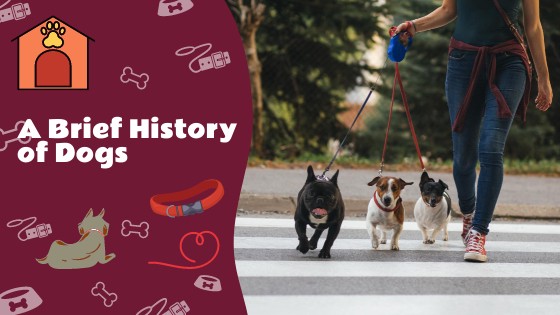
From a wide range of sizes, shapes, and temperaments, to different coat colors and patterns, the modern dog has been shaped by centuries of selective breeding. To understand the long and complex history of these beloved animals, it is important to look at how they evolved throughout the ages.
Prehistoric Dogs: A Look At Their Origins
Prehistoric dogs are thought to have descended from the gray wolf and are believed to have been domesticated sometime between 19,000 and 32,000 years ago.
Studies of the DNA of modern dogs and other canines suggest that domestication likely occurred in East Asia, with Chinese fossils showing a mix of human and dog tooth marks, indicating that they were the first to be domesticated.
There are a number of theories as to what drove hominids to first begin interacting with wolves, including the need for protection and assistance with hunting.
As humans moved from a nomadic lifestyle to a rural one, dogs became increasingly useful for herding and guarding livestock and aiding humans in hunting and food gathering.
The Role of Wolves in Dog Domestication
It is believed that wolves played a crucial role in the process of domestication. As humans began living in close proximity to wolves, those that were smaller, less aggressive, and less prone to biting were most likely to be approached and tamed by humans.
These wolves were then selectively bred for certain desirable traits, such as friendliness and loyalty towards humans, as well as for utilitarian purposes like hunting and herding.
All modern dog breeds have descended from these early domesticated wolves, meaning that every dog alive today can trace its ancestry back to these animals.
Despite the fact that modern dogs have been genetically modified throughout the years to the point of being almost entirely new species, they are still genetically very similar to their wild cousins.
The Ancient Egyptians and the Development Of Breeds
Ancient Egyptians were some of the first to domesticate dogs as a means of protection and companionship. The most common breeds during this time were sand dogs, desert dogs, and black dogs, which were most likely domesticated jackals.
There are various depictions of dogs in ancient Egyptian art and artifacts, and it is thought that they were primarily kept indoors in order to guard the house, as well as to act as a source of heat.
Although they were undoubtedly prized and loved animals, they were also likely killed and eaten during times of scarcity. Ancient Egyptians are credited with the first known use of dog breeds as a means of delineating status.
It is believed that royalty, along with some members of the upper class, kept a breed of dog known as the Pharaoh Hound, which was bred for hunting gazelle and hare.
Roman Dogs and the Rise of Popular Breeds
The Romans were responsible for the widespread popularity of certain breeds of dogs, as well as the proliferation of the practice of using dogs as household pets.
These societies are credited with creating some of the earliest domesticated breeds, such as the German Shepherd, Pug, and French Bulldog. Like the Egyptians, the Romans utilized selective breeding as a means of differentiating status, with certain breeds being kept only by the elite.
It is believed that the Pug was originally bred in China, and was later imported to Italy and France, where selective breeding for its unique appearance began.
In addition to being a common household pet, the Pug was also utilized as a therapy dog. The German Shepherd was originally bred as a guard dog and herder but has since become an incredibly popular breed used in various capacities, including therapy, law enforcement, and service.
Medieval and Renaissance Dogs
During the Middle Ages, dogs were primarily used for hunting and herding, with some being kept as guard dogs and pets. It is believed that the English Bulldog was first bred during this time, likely as a means of entertaining English nobles.
The Renaissance saw the creation of more dog breeds as more households began keeping dogs as pets, with some breeds being created for specific purposes, such as hunting and herding. It is believed that French Bulldogs were first bred during this era, with their unique appearance resulting from inbreeding.
During the Renaissance, there was a shift in how dogs were treated and viewed. It is believed that this was partially driven by the advent of the printing press, which allowed for the wide dissemination of information about proper veterinary care and treatment for dogs.
The Industrial Revolution and Development of Breeds
To complete reading the article, click on the link
0 comments
Be the first to comment!
This post is waiting for your feedback.
Share your thoughts and join the conversation.
